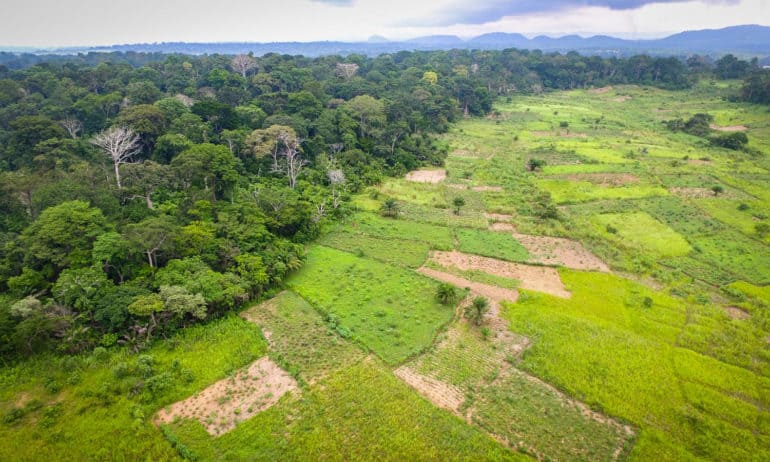Photo Credit: Mokhamad Edliadi/CIFOR
Matthew Cooper uses data science to study land cover and nutrition as part of his PhD in Geography at the University of Maryland. His interest in the environment and food systems has led him to conduct fieldwork in countries including Mali, Uganda, and the Philippines; act as data manager for a project that harnesses data for agricultural decision-making; and work on remote sensing and geographic information system (GIS) projects. Cooper’s passion for ecosystem services and nutrition led him to apply and be a finalist in the 2017 Barilla Center for Food and Nutrition (BCFN) Young Earth Solutions (YES!) Research Grant Competition. His project proposal, Using Forests to Support Nutrition During Times of Drought: A Multinational Social-Ecological Analysis, aims to explore how forests support nutrition during periods of low rainfall.
Food Tank had the opportunity to talk with Cooper about his BCFN research proposal and his other research pursuits related to forests and ecosystem services.

Food Tank (FT): Can you tell us about your doctoral research on land cover and nutrition in the developing world and how it relates to your project proposal for the 2017 BCFN YES! Competition?
Matthew Cooper (MC): My doctoral research is very much in line with my BCFN project proposal. I am combining over half a million geolocated child health observations with data on factors such as land cover and precipitation patterns. The goal of my research is to determine where forests and other natural areas can buffer child nutrition from the effects of climate shocks.
FT: What are some of the ways that forests can act as buffers for food security and nutrition during times of climate stress?
MC: Forests, and other natural areas like rivers and grasslands, provide many ecosystem services to communities, both during normal years and during times of climate stress. For example, these areas provide a number of wild foods such as bushmeat, honey, fruits, nuts, seeds, and fish. These foods can make communities less dependent on rain-fed agriculture, acting as a ‘safety net’ when agriculture fails. Forests can also provide several benefits to local agriculture. They create microclimates, retain soil moisture when there is too little rain, absorb excess water when there is too much rain, and provide pollinators and regulate pests. All of these factors can help keep yields high during climate shocks.
FT: Could you tell us a bit about major drivers of deforestation in the areas that you study?
MC: In the areas I study, deforestation is driven almost entirely by agricultural expansion. This isn’t always a bad thing—the world’s population is growing, poor countries are developing quickly, and agribusiness can be a path out of poverty while meeting food production needs. However, in some communities too much agricultural expansion can negatively impact livelihoods and nutritional outcomes. This is especially the case for those located far from markets and job opportunities who depend on local ecosystem services. Evidence shows that this is the case in Sikasso, Mali, where over-enthusiastic farming of cotton is frequently blamed for the region’s unexpectedly poor rates of child malnutrition. Equality is also an issue. Often the benefits of natural areas go to an entire community and are essential for the poorest members of the community. The benefits of deforestation, including money from timber and charcoal, and cash crops from agricultural land, only go to the wealthier members of communities. The worrying phenomenon of land grabs—where national governments sell large swaths of land to foreign governments or companies with no regard for the locals—can be especially destructive for local livelihoods and ecosystems.
FT: Are there any innovative programs or policies that you are excited about that protect forest areas of key livelihood significance?
MC: There is a body of evidence that decentralized, community-based forest management can lead to win-wins in terms of local livelihoods and environmental conservation. The old-fashioned top-down approach to conservation—build a fence around the forest and kick the people out—is increasingly recognized as detrimental to local livelihoods. In some cases it can also constitute a major human-rights violation; an example of this is the Batwa in Southeast Uganda. Empowering local people to control their own natural resources and letting them make the key decisions, with some outside support/structure from non-governmental organizations and national governments, can allow individuals to meet their livelihood needs while also incentivizing sustainable resource use.
FT: You authored a recent discussion paper published through the International Food Policy Research Institute (IFPRI) on ‘Using natural areas and empowering women to buffer food security and nutrition from climate shocks: Evidence from Ghana, Zambia, and Bangladesh.’ What are the interactions or linkages between women’s empowerment and ecosystem service availability?
MC: Good question! Livelihood roles are often separated by gender in agrarian communities in developing countries. In many cases, critical forest-sourced resources are entirely collected and processed by women. In West Africa, for example, women are in charge of collecting and processing Shea, the main source of lipids in their diet, as well as Soumbala/Netetou/Dawadawa, a major protein source from the Parkia biglobosa tree. In the paper you mention above, I tested the hypothesis that empowered women would be more able to utilize and conserve these resources.











